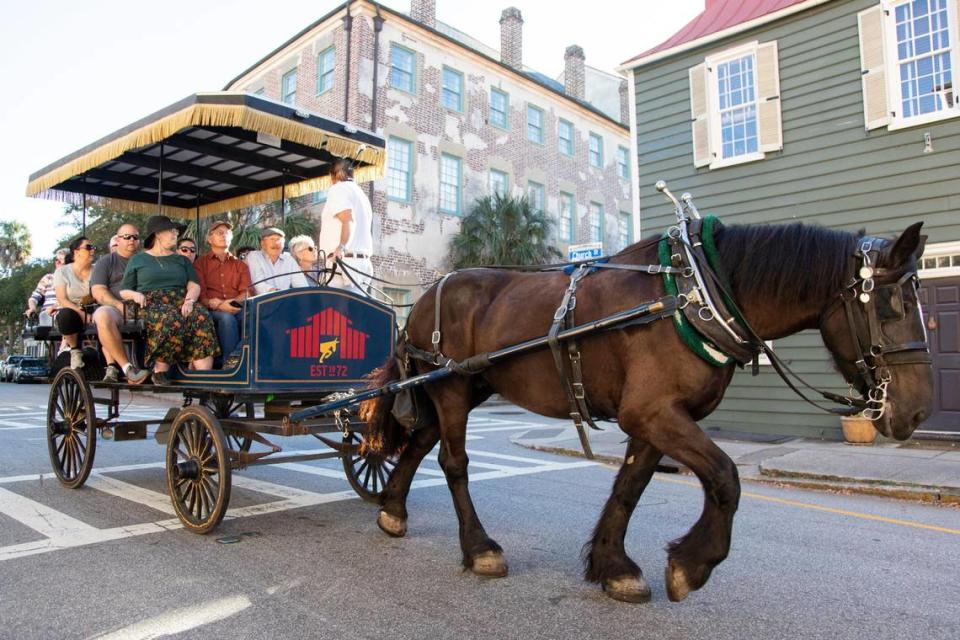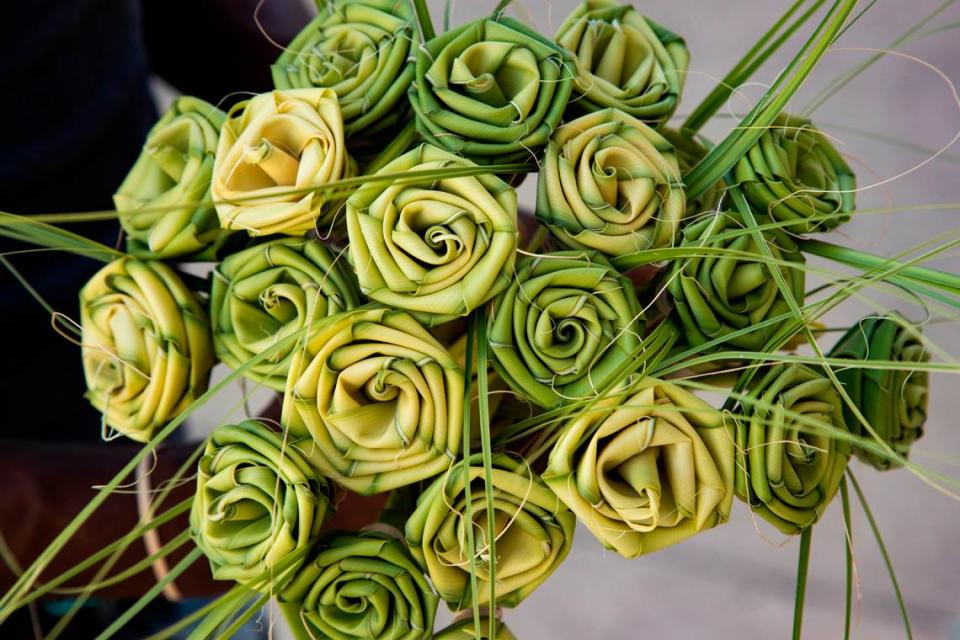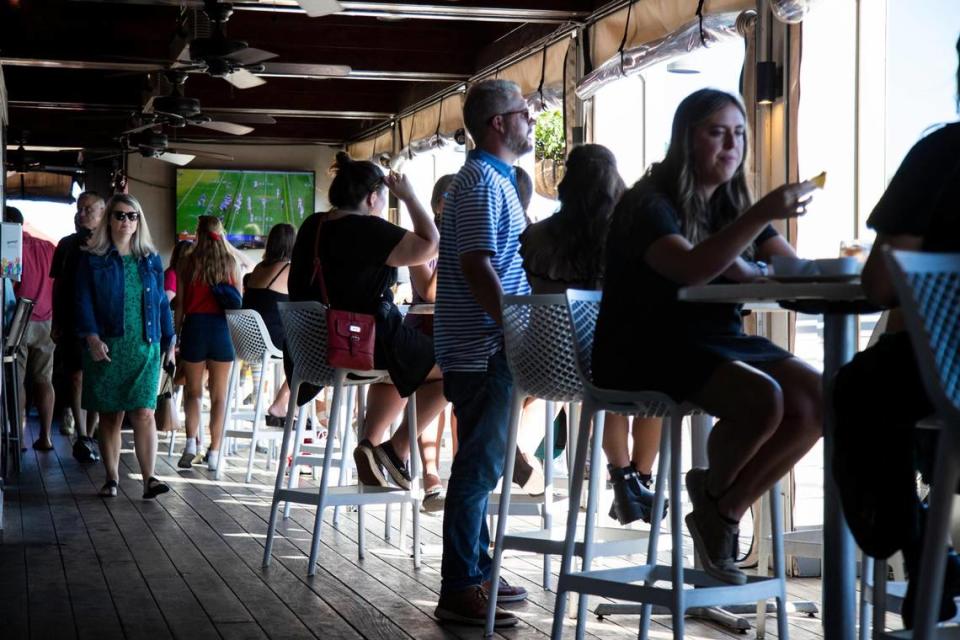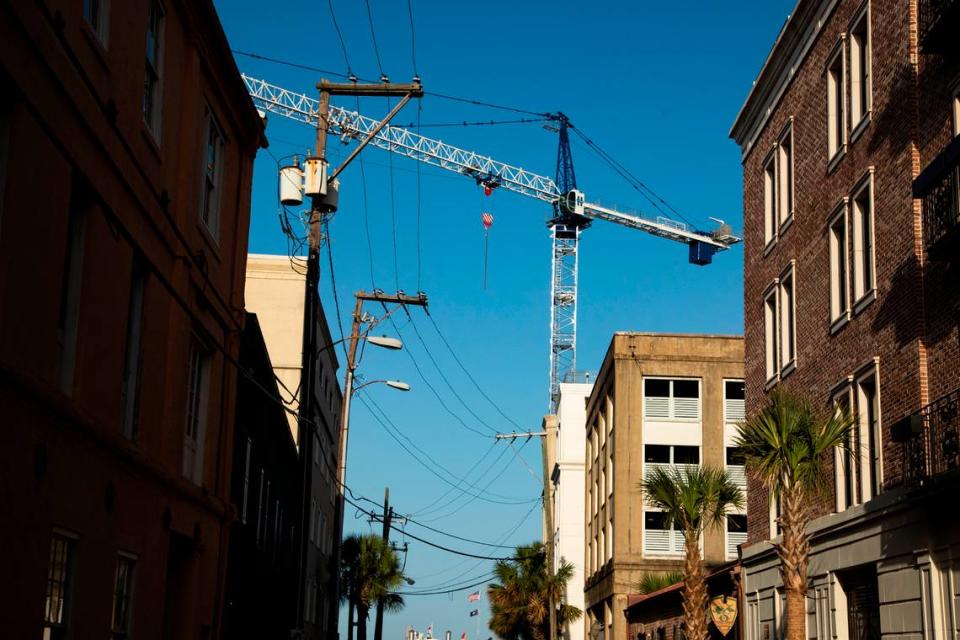Historic SC city fears losing authenticity. Will outsiders drown out Charleston natives?
More than a century ago, during his first trip to Charleston, Alfred Hutty sent a telegram to his wife.
It was the winter of 1919, and Hutty was a man in search of warmer weather. He had left an emerging art colony in Woodstock, New York, and traveled south at the suggestion of his mentor.
Soon after his arrival in Charleston, the master painter found himself sending an urgent message back home.
“Come quickly,” he wired his wife in New York. “Have found heaven.”
Some 102 years have passed since Hutty sent that famous five-word dispatch, and the world is still cooing over Charleston.
National magazines can’t stop writing about the understated majesty of this Holy City, where church spires dot the downtown skyline. Photos of the pastel-colored homes that give Rainbow Row its name draw thousands of likes on Instagram. And in an announcement this fall that surprised absolutely no one who lives here, Travel + Leisure readers declared for the ninth year in a row that Charleston is the No. 1 city in the United States.
This region, where historic downtown streets are narrow but highways keep widening, is a place that literally moves people.

The Charleston metro area, which includes Charleston, Berkeley and Dorchester counties, grew a whopping 20% in the last decade when it added some 135,000 residents to the region, according to the latest 2020 U.S. Census data.
And that rapid growth is happening not because current residents here are having babies. This boom is increasingly being fueled by people moving here “from off,” as the locals say.
The Gullah-Geechee, descendants of the enslaved Africans who were brought to South Carolina’s Lowcountry to work the rice and indigo plantations, have another name for these new residents: “Come-yahs.”
And they just keep coming here, 33 new people each day of the year.
That growth shows no signs of abating.
Researchers at the Charleston Regional Development Alliance now estimate that more than 1 million people will call the Charleston area home by the year 2029.
By 2040, the region’s current population of nearly 800,000 is expected to double in size, said Ron Mitchum, the executive director of the Berkeley-Charleston-Dorchester Council of Governments.
That means more people on already congested roads and bridges, more people searching for a place to live in a place that can’t grow much bigger and more people laying down roots in a place with a deeply rooted sense of identity. Already, there’s a rush to play catch-up.
Elected officials in the tri-county estimate the Charleston area’s infrastructure needs are so great that there is about $8 billion in infrastructure project needs right now. Real estate agents say they’ve never seen housing stock this low, and rental prices keep ticking upward each year, even as wages in this tourist-heavy economy do not.
“It’s a mixed blessing,” Charleston Mayor John Tecklenburg said three different times during a recent interview about the region’s persistent growth. “It’s not surprising to me, but it is, admittedly, a challenge to even think about it.”

As the Charleston area contends with the dilemmas that come with decades of steady growth, like increased traffic and housing affordability concerns, it must also face another matter that gets to the very soul of this place: its people.
Charleston’s 10-year plan, which was recently finalized, acknowledged this struggle, writing that recent trends show “the city is losing the diversity that has played such an important role in shaping what makes Charleston unique.”
As more people move here from elsewhere, the city begins to wonder: Will anyone actually be from Charleston in the future? And does this shift in population put this Southern destination at risk of becoming a seersuckered caricature of itself?
A seminal period
In 1994, just as it does now, the city of Charleston had real concerns about its growth.
Traffic congestion topped the list, along with parking, sanitation and the availability of public restrooms, according to city documents. But there was also another fear that loomed as the city experienced a surge in tourism: the potential “Disneyfication” of Charleston.
But asked during a recent interview if he fears Charleston is at risk of becoming a Disneyland of the South, the mayor of South Carolina’s largest city shook his head “no.”
“People that move here get into it. They absorb the history. They learn about Charleston. They relish in it,” said Teckleburg, a Charleston native himself. “I mean, you just get a sense of pride being a Charlestonian. I don’t care if you came here 150 years ago from Germany or moved here from New Jersey last week, you know, when you come here, you drink the water, and it — that passion for this place — it’s just contagious. You become a part of Charleston.”

Katie West is now part of this place. The 39-year-old Columbia native moved here in 2005, moved away in 2015 and returned in 2019.
Her relationship with the Holy City began when she took a college course about historic preservation at Clemson University and became fascinated by Charleston after a few class trips.
But unlike the mayor, West said she worries this place is at risk of losing what makes it special. She was heartbroken when the old Charleston County Public Library building on Marion Square was demolished to build the Bennett Hotel.
The library was the only mid-century building in the city and was the first public building designed and built after desegregation.
“It was covered in pink marble, and we just demolished it and created this Disney-fiction version of Charleston right in the heart of downtown Charleston,” she said.
Cashion Drolet, a born-and-raised Charlestonian and chief advocacy officer for the Historic Charleston Foundation, said she, too, has concerns about Charleston losing its identity.
“I worry about it becoming a page out of a Southern Living advertisement if we aren’t careful,” Drolet said.
In her day job, Drolet pushes for the preservation not only of historic buildings, but of entire neighborhoods. Preservation, she said, cannot only be about saving big mansions and the homes along The Battery. It must also be about people and sense of place.
She cites the Phillips community in neighboring Mount Pleasant as an example.

The settlement community along both sides of S.C. Highway 41 dates back to the late 1800s, when formerly enslaved Black people purchased this land after the Civil War. For generations, they passed it down to their descendants, many of whom still live there today.
But this historic community has found itself fighting to survive in a booming Mount Pleasant. The two-lane road that was once a rural stretch of highway is today overwhelmed by traffic that spills out from a slew of nearby subdivisions.
When a new road plan proposed widening Highway 41 from two lanes to five, the renderings showed it slicing right through the historic Phillips community. The plan set off emotional public debate about who must bear the brunt of development pressures.
“Will the history, culture and artifacts of the African American settlement communities in Charleston County be destined to be contained within a museum?”Jennie Stephens, the CEO of the Center for Heirs Property Preservation, asked in a letter to the editor published by the Post and Courier newspaper last year. “Will the legacy of these families who helped make Charleston what it is be lost as development occurs to accommodate this growing region?”
It is a story that many expect will not end with the Philips community, which, for now, has secured a historic designation that gives it some protection from ongoing development.
“We’re in a seminal period right now, where the choices that we’re making are going to define our future, whether we’re talking about tourism management, our environment, the affordability factor or our ability to preserve the culture and the people that make Charleston what it is,” Drolet said.
“It’s tough,” Drolet continued, letting out a sigh. “The secret’s out. People want to be here. And we have to find a way to make room for them.”
Driving Charleston’s growth
John Bell fell in love with Charleston slowly and then all at once, the same way an afternoon storm rolls in at Folly Beach in the summertime.
Years ago, while living in Pennsylvania and working in the high-octane world of finance, Bell said he first experienced Charleston as a summer tourist. But with each trip, where he golfed, ate good food and went fishing, he grew more certain that he would do whatever it took to get here for good.
His best friend made the leap first in 2012, when he ditched his own high-pressure job, moved to Charleston and traded those bitter northeastern winters for sticky Southern summers.
“And frankly, I saw a change in him. He was a different dude after he got down here,” Bell said. “He was happier.”

Four years later, Bell decided it was time for him to do the same. He left his job working as an executive for PNC Bank and in 2016 moved to Charleston, where he reinvented himself and decided to get into real estate.
His real estate firm is aptly named Southern Bell Living, but there’s a bit of an ironic twist here. None of his firm’s real estate agents are from Charleston.
Each team member, the company’s website writes, has “chosen Charleston as their adopted home and recognizes everyday how lucky we are to live and work here.”
“People know real quick we’re not from here,” Bell said, letting out a big laugh. “We’re not from Charleston, and that’s, for sure, not a negative thing.”
In fact, it’s becoming increasingly common.
From 2015-2019, South Carolina natives accounted for less than half the population in both Berkeley and Dorchester counties, while 51% of Charleston County’s population was born in the Palmetto State.
That’s similar to what other coastal counties in the state are seeing, too. In Beaufort County, seven out of 10 residents are not from South Carolina. In Horry County, 63% of its county residents aren’t from the Palmetto State, either.
But a Charlestonian may be even harder to find.
The State conducted an informal survey of nearly 70 current and former Charleston-area residents. The results showed that a majority of respondents, 69%, said they either “rarely” or “sometimes” meet someone who is originally from Charleston.
When asked how they wound up in the Charleston area themselves, 44% of respondents said they moved here in the last 10 years, compared to 35% who self-identified as a Charleston local.
Jodi Renegar, a research analyst for the Charleston Regional Development Alliance, said more sophisticated data sets tell a similar story.
In-migration, or people moving here from elsewhere, far outpaces the live births happening here each day, Renegar said. A decade ago, about 70% of the Charleston metro’s population growth was due to in-migration. In 2020, Renegar said it accounted for 83% of its growth.
So where are all these new residents coming from?

While the New York metro area continued to be the leading source of Charleston’s new residents for the second year in a row, national change of address data from the U.S. Postal Service shows three other big-city destinations elbowed their way into the top 10 list of Charleston’s feeder cities for the first time last year: Los Angeles, Boston and Miami.
That means seven of the top 10 cities that fueled the Charleston area’s growth in 2020 were large metro areas: New York, Atlanta, Charlotte, Washington, D.C., Miami, Boston and Los Angeles.
The remaining feeder cities can be found in the Palmetto State: Columbia, Greenville and Myrtle Beach.
“People in these huge urban metros are looking for an alternative,” said Renegar.
That was the case for Bell and is now the case for many of his clients, whom Bell said are eyeballing the region from places like Chicago, California, Texas and neighboring North Carolina.
These new residents are drawn to Charleston for the promise of a slower pace, a better work-life balance and more access to nature, whether it’s going to one of the nearby beaches or having a yard for the dog.
For Mary Pusterla, she’s drawn to this place because it is home.
But finding a house here? That’s proving to be a challenge for both Pusterla and the region at-large.
The cost of living
Almost from its inception more than 350 years ago, Charleston seemed to have big-city aspirations thrust upon it. When it was just a colony of the crown, it earned the nickname “little London.”
Now, in 2021, the Charleston region finds itself struggling to retain its small-city charm while contending with big-city concerns, chiefly housing affordability and infrastructure demands.
In the city of Charleston alone, a recent study found the city will need 16,351 affordably-priced homes and apartments over the next decade to meet the expected demand.
Couple that with another hard truth: The Charleston region is an expensive place to live. According to a 2021 Urban Land Institute report, Charleston is the 28th most expensive place to buy a home in the entire country.
This region is also the second-most expensive metro area in the Southeast, second only to Washington, D.C. But in the nation’s capital, the median household income is 28% higher than Charleston’s, suggesting that the wages here are not keeping pace with what’s needed to live and work here.
Pusterla knows that story well. Born at Trident Hospital in North Charleston and raised in Summerville, the 32-year-old did everything she could think of to stay here.

After graduating from the University of South Carolina in 2011, she applied for jobs in Charleston and all across the state. She had wanted to use her degree in visual communications. Her dream job was to be a photojournalist.
But when she couldn’t find a job, no matter how hard she tried, she wound up heading west to a small town in Colorado, where she worked as a designer at a small newspaper. She met her now-husband, and the two moved to Amityville, New York, his hometown.
Now, the pair is hoping to move South to her hometown of Charleston. But Pusterla said she also carries some guilt about what her return could mean for other locals.
“There are definitely people being priced out of their cultural homes, and I hate to feel like I might be contributing to further gentrification by having gone away, having gotten a New York salary that supports the high cost of living where I’m at now and the high cost of living I’m seeing in Charleston,” said Pusterla, who frequently browses home listings on Zillow. “The truth is, I don’t think I would have even been able to even consider making this move if I hadn’t made these moves and left.”
Pusterla, who began browsing Charleston home listings online last year, mentions Johns Island. When she was growing up, that island was secluded, rural and agricultural. Last year, while scrolling on Zillow, she saw a house listed there for $300,000. Six months later, she said, she saw it had been relisted for about $600,000.
In a recent interview, Charleston’s mayor described housing affordability as an immediate need. In his state of the city speech he delivered earlier this year, Tecklenburg called it a crisis.
“Without decisive action, Charleston could one day become less a city, and more a fleeting pleasure for well-to-do visitors, out-of-state students, and part-time second home owners,” Tecklenburg said in January.
“We’ve got to approach it from all angles, and we’re trying to use every tool available and create more affordable housing units in our city,” the mayor said in an interview.
Some of those solutions are already underway and involve getting creative about what already exists and creating density where it makes sense.
For example, a 12-unit affordable housing complex that already exists at 275 Huger St. will soon be replaced with a new building that will be home to 85 mixed-income affordable housing units. Residents in the city limits will also now be allowed to build an accessory dwelling unit in their backyard.
“We’ve got a lot of single-family homes in the city, not just downtown but all over, where there is room for another small dwelling on the property for family or as an affordable rental. And, you know, that’s one more housing unit that wouldn’t have to be on the other side of Summerville, you know, yet increases the density,” Tecklenburg said.
The city has also made changes to the bureaucratic application process for developers that is meant to incentivize the private sector to build affordable housing. If a proposal includes affordable housing, the mayor said that project is flagged and put at the top of the stack for city staff to review.

In neighboring Mount Pleasant, managing explosive population growth has been one of the town’s biggest challenges. While Charleston grew by 17% in the last decade, the town of Mount Pleasant, located just east of peninsular Charleston over the iconic Arthur Ravenel Bridge, saw its population grow by nearly 33% during the same time period.
“If you’ve got high growth numbers, your residents get real tired of that kind of growth real fast,” said Mount Pleasant Mayor Will Haynie said after the latest Census figures came out.
Mount Pleasant has been among the fastest-growing large cities in the country, despite it technically being a town. The latest Census figures show its population now exceeds 90,000.
Haynie, who was first elected to Town Council in 2015, supported a cap on development, especially residential development, less than a year after he was elected mayor in 2017.
The town’s efforts to try to manage its growth in recent years include a ban on new apartment developments, imposing limits on annual building permits and putting height restrictions on buildings to keep the character of this place intact despite its swelling population size.
“For eight of the last 10 years, we had unrestrained growth. And we tried to fix that,” Haynie said. “In Mount Pleasant, what we first had to do was we had to put the brakes on and say hold on … because once you turn that corner and you start doing more urbanization, you’re gonna look like suburban Philadelphia and Charlotte, and we do not want that.”
But Mount Pleasant is also contending with issues of affordability.
According to the nonprofit Housing for All, approximately 70% of workers in Mount Pleasant live elsewhere. Haynie said his own adult daughter is having to move out of Mount Pleasant.
“She’s having to move downtown,” the mayor said. “She can’t afford the $1,800 a month rent her landlord wants.”
Charleston’s existential threat
For Charlestonian Alex Rosen, he’s admittedly conflicted about his hometown’s relentless popularity.
On the one hand, he said, he’s glad to see newcomers bringing fresh ideas and loves how that has translated into a transformation of the city’s now-famous food scene. But there’s still a gnawing worry he has about all this growth.
Rosen, 44, said he felt that internal struggle on a recent weekday morning, when he arrived for work at his downtown office on Broad Street.
As he unlocked the door, he heard the shouts of tourists and the inconsolable wails of a screaming child. Then, a walking tour of 25 people sauntered past him.
“It’s over,” Rosen said he thought to himself as he absorbed the scene. In that moment, he was mourning the loss of the Charleston he knew even as the city still stood before him.
When he was growing up here in the 1980s, Rosen said, the roads and sidewalks downtown were quieter, less busy. They were not, as they are now, choked with tourists and bachelorette parties.
The first time Rosen said he heard someone honk their horn on King Street, he jumped.
“I’m internally torn. I’m struggling with it,” Rosen said, “because I believe as a true Charlestonian you should welcome people from off, but how do you welcome people when you don’t have the space? Where are they supposed to go?”

Jerome Smalls is more worried about how locals are supposed to stay.
The 70-year-old civil rights activist said he has seen Charleston residents, especially Black people, priced out of this region. He recently took his concerns outside Charleston City Hall, where he stood holding a sign on a Friday afternoon.
His homemade sign read, “Racist uses of gentrification turns a slave port into all-white city.”
“Black people used to live down here on Queen Street,” Smalls said. “And now you can’t even find Black families past Calhoun Street, past Columbus Street.”
The Census data shows the exodus, too.
With a drop in 11,700 people, no county in the state of South Carolina lost more Black residents than Charleston did in the last decade. That fact made Smalls sigh deeply.
Does he think Charleston is losing its identity?
“It already has,” he said.
Grahame Long moved to Charleston in 1996 right after college, drawn to the city’s rich place in American history.
But soon after his arrival, Long noticed how many people he met who had a strong connection to Charleston, not only as a place but as a part of their identity.
“I grew up in Charlotte, in the most soulless city in America,” said Long, who worked as a curator at the Charleston Museum for nearly 20 years. “But that strong connection that people have to this place, to Charleston, was like nothing I would ever experience in Charlotte, N.C. And I took that to heart.”
He continued, “I moved into something unique here.”
And that feeling, he said, has never quite waned.

 Yahoo Movies
Yahoo Movies 
